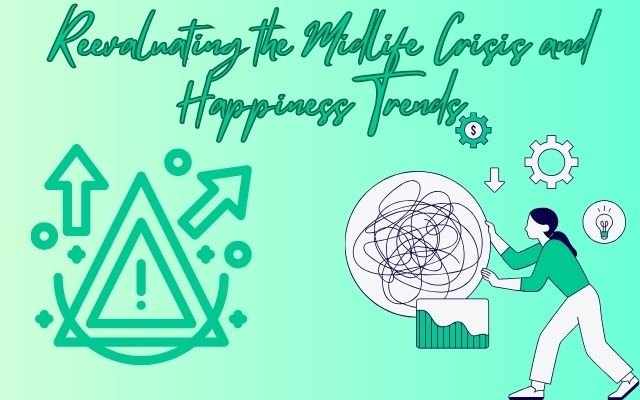Midlife Crisis: More Than Just a Simple Story, Say Researchers
Researchers challenge the midlife crisis narrative, revealing diverse happiness trends across ages and cultures. Discover new insights.

The concept of a midlife crisis is becoming less popular, and some experts believe it may never have existed in the first place. It may be time to give this notion a thorough reexamination, according to researchers who are currently reviewing the evidence supporting it.
Decline of the Midlife Crisis Concept
Concept that happiness tends to decrease during midlife, only to rise again later, has been popular since the mid-1960s. By the late 1980s, social scientists had gathered data from well-being surveys worldwide, claiming that this trend was both measurable and universal. This gave rise to idea that a midlife crisis is a difficult time when many people feel miserable and unfulfilled.
Recent research, however, is casting doubt on this long-held notion. Happiness patterns in different cultures, particularly in nonindustrialized societies in Asia, Latin America, and Africa, have been the subject of an increasing number of studies. These places have often been overlooked in previous research. The new findings indicate that happiness doesn’t necessarily follow the same downward trajectory during midlife as previously thought.
Instead of a universal midlife crisis, the research reveals different patterns of happiness that vary widely among cultures. Happiness can take a different path in some groups after midlife while in others it may not decline at all. This implies that personal experiences of happiness are far more nuanced and that the narrative of midlife crisis may not be applicable to everyone.
Idea that there may not be a single, universal solution to the midlife crisis is becoming more & more evident as researchers continue to examine these many viewpoints on happiness. This change in perspective highlights how important it is to see happiness from a wider perspective, taking individual circumstances & cultural variances into account rather than depending only on a generalized theory.
By offering new viewpoints on happiness & midlife experiences, a recent study that was published on October 23 in Science Advances challenges conventional wisdom around the so-called “midlife crisis.” According to the study’s findings some people may start to lose their happiness years earlier than previously believed. They also discovered that happiness can peak in midlife for some individuals although exact reasons for this are still unclear. More commonly, they observed gradual decline in happiness starting around age of 45.
Understanding U-Curve of Happiness
This study adds to ongoing debate about U-curve theory of happiness which suggests that happiness follows a U-shaped pattern over person’s lifetime. In this model, happiness is plotted on the vertical axis (y-axis) and age on the horizontal axis (x-axis), forming a distinct U-shape where happiness is higher in youth and later life, with a dip during midlife. This concept gained popularity after it was first published in 2008 and has been supported by many studies.
Though it has been criticized for years, the U-curve idea has recently drawn increased attention. Economist David Blanchflower, who initially contributed to the promotion of the U-curve theory, has specifically said in public that the theory may no longer be valid. According to him, one important element that changes the patterns of pleasure across age groups is the rising levels of unhappiness among teenagers and young adults, particularly among women & girls. “The U-shape curve has now all but disappeared,” says Blanchflower, emphasizing necessity for scholars to concentrate more on the problems that today’s youth face.
According to several experts in the field such as psychologist Nancy Galambos of the University of Alberta, the discourse surrounding midlife crises might have originated from a desire for simple explanations of intricate issues. She asks whether researchers are still searching for a single, simple explanation of happiness that may not exist and warns that emphasis is moving to narrative about a “adolescence crisis.”
Brandeis University psychologist Margie Lachman also cautions against perils of simplistic ideas. She contends that because U-shape model places a lot of emphasis on midlife, it obscures issues surrounding happiness in other age groups.
Blanchflower and economist Andrew Oswald previously supported the idea that happiness declines in midlife with their 2008 study, which indicated that populations from over 70 countries displayed similar U-shaped trends in happiness. This theory gained additional support from a 2012 study suggesting that even great apes experience midlife blues, hinting at a potential biological basis for the phenomenon.
However, U-curve idea has been criticized for having shortcomings. According to sociologist David Bartram, U-curve might be a statistical illusion brought on by the attempt to separate the “pure” effects of aging. Researchers frequently adjust for things that can impact happiness such as divorce and health conditions but Bartram contends that ignoring these factors could distort the total picture of happiness as people age. According to him researchers must account for adverse events that may occur later in life in order to obtain comprehensive understanding.
Another viewpoint is that certain historical occurrences including Great Recession, may have had an impact on the U-curve’s results. In the United States, for example, a long-term study called Midlife, which has been gathering data since the mid-1990s, found that middle-aged people in the 2011 data collection (which took place at the height of the recession) reported worse health and well-being than people in previous cohorts.
Story surrounding the midlife crisis and the U-curve of happiness may require substantial reevaluation, according to new study. It’s important to take into account the varied experiences of people at various ages & situations rather than depending solely on one hypothesis.
Impact of Technology on Adolescent Well-being
Technology especially smartphones and social media, has changed life for today’s young people. Psychologist Margie Lachman says that teens who grew up with these tools face different challenges than those from earlier generations. COVID-19 pandemic made it even more common for young people to connect online, which has harmed their mental health.
According to economist David Blanchflower, concept of U-curve of happiness shouldn’t be entirely disregarded. According to this theory, people’s happiness often increases as they get older and younger & decreases as they get older. Blanchflower notes that it’s difficult to deny existence of this U-shape because numerous investigations demonstrate it. However, he also thinks the pattern of happiness has changed and that we’re in a new situation.
Blanchflower realizes that by focusing too much on the U-curve, he may have missed the growing mental health problems among teenagers. He notes that changes in how happy young people feel started around 2013, but researchers didn’t pay much attention because they were focused on midlife issues.
Lachman is worried about the struggles faced by today’s youth. Still, she thinks that just switching the focus from midlife crises to adolescent crises isn’t enough. While it’s true that young people are having a tough time, it doesn’t mean that people in midlife are doing well. She points out that the happiness of young people is closely linked to how their parents and teachers feel. If adults are also struggling, it can make things worse for kids.
- Betelgeuse Has a ‘Betelbuddy’: New Findings on the Bright Star’s Companion
- 10 Surprising Psychological Facts About Human Behavior You Didn’t Know
- The Science Behind Sleep: Why You Need It
According to Lachman and Blanchflower, a significant number of teenagers nowadays are dealing with severe mental health problems. They stress the importance of comprehending happiness for people of all ages. The experiences of older folks are linked to the issues faced by young people. The general image of happiness throughout eras should be taken into account as researchers investigate these problems.



